
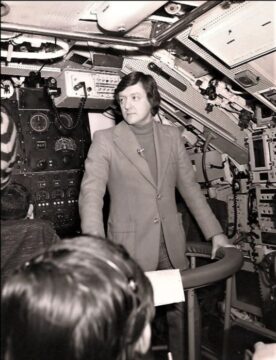
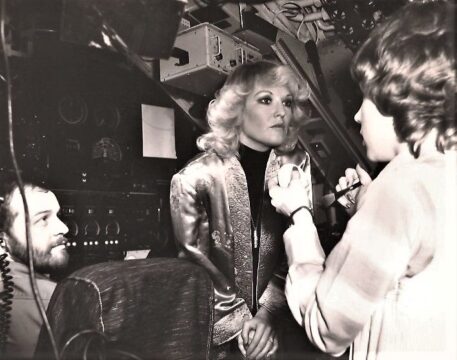
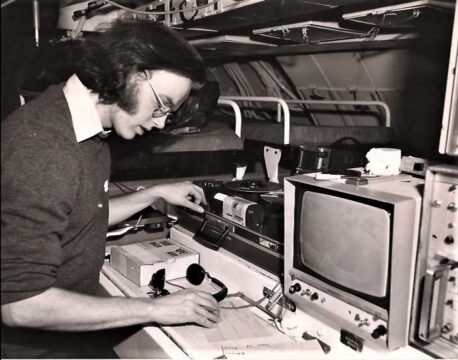
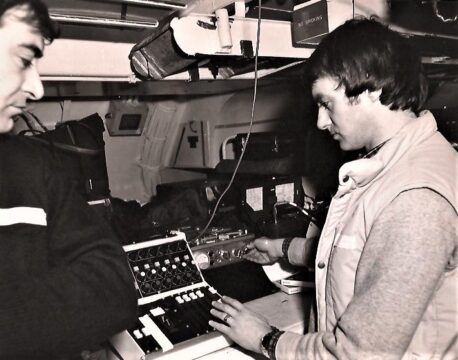
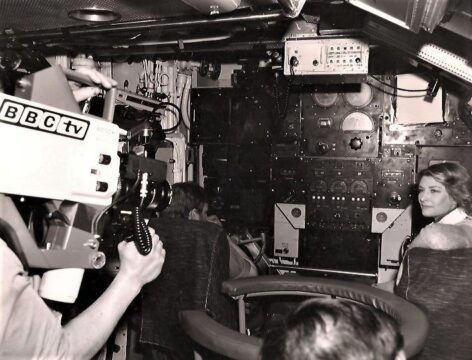
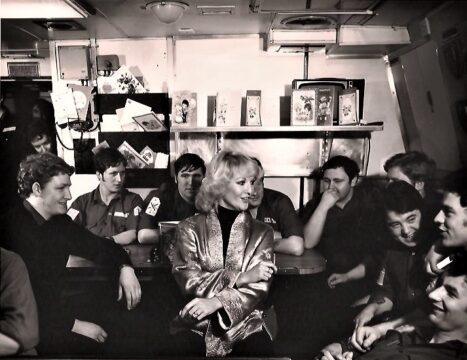
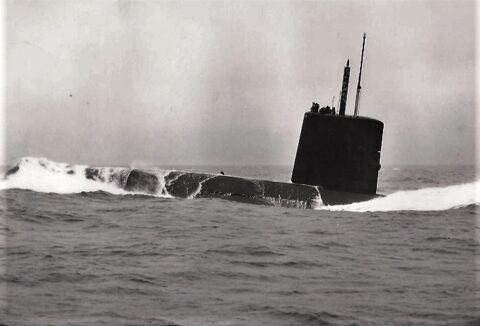
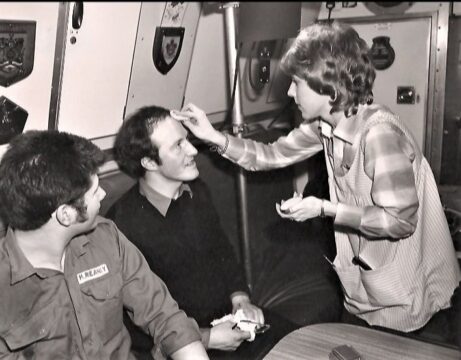
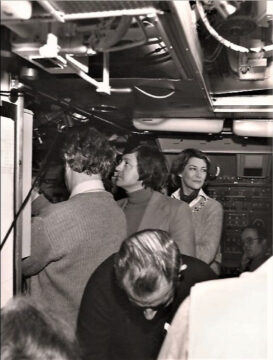 Pebble Mill at One: HMS Dreadnought – 14/2/80 ………..
Pebble Mill at One: HMS Dreadnought – 14/2/80 ………..
And…..cue the submarine”.
With those words [surely one of the best ever cues over talkback!] John Smith, the Director, began yet another “first” for the Pebble Mill @ One team with a live broadcast from a nuclear submarine, HMS Dreadnought, near Faslane off the west coast of Scotland on the 14th February, 1980. The submarine took it’s cue, broke through the surface of the choppy Firth of the Clyde and appeared in all it’s glory to the music of the opening title sequence. What happened next – I will never forget.
John Smith was an inspirational Producer/Director and not exactly known for taking “No” or “It can’t be done” for an answer. He was the driving force behind many of Pebble Mill’s ambitious live programmes – particularly those involving the military.
On this occasion, I was the sound supervisor working alongside Roger Slater with cameraman John Couzens and engineer Jim Cleland onboard the submarine with our presenter, Bob Hall. The rest of the OB crew were on the mainland in an OB/links truck on the Isle of Arran.
The previous day had gone very well. The weather had been kind to us whilst we pre-recorded items for the next days’ live broadcast. We interviewed various crew members, recorded Lyn Paul singing Rod Stewart’s “Sailing” with the crew joining in on the chorus for good measure. We also filmed a mock battle sequence from the control room. I will always remember Commander Johnny Clarke giving the order: “Prepare to surface and standby to machine gun the survivors!” He was joking of course. Probably. Also, who knew that a nuclear submarine on full power can aquaplane – well it can, and did, although we weren’t allowed to film it. I have to admit we also pre-recorded the opening sequence of the show with the submarine breaking the surface – getting the timing right and not knowing exactly where it would surface was a bit too risky to do live. The cables from the mics and the camera were fed from the conning tower down through the hatch into the submarine. Stationed by the hatch at all times was a sailor with an axe. When we enquired what he was doing we were told that in an extreme emergency he would cut the cables, close the hatch, then the submarine would dive – with, or without us!
Early next morning – transmission day, we boarded the submarine at sea from a tender and joined Jim Cleland, who had spent the night on board sorting out the comms. Already things were different. The weather had turned and there was a storm brewing. On paper, the ‘live’ segments of the programme were deliberately straightforward – KISS (keep it simple stupid) had long been my mantra. We just had three live one-plus-one interviews, an opening piece and a closing from our presenter, Bob Hall, together with live links into the previously pre-recorded VTs – it should have been easy. For anyone interested, I was using a Glensound 6 channel mixer with 4 x ECM50 personal mics, an AKG 416 FX mic, and a standby Electrovoice 635 hand-held stick mic.
My mixing location was deep in the bowels of the sub – not too far away from the torpedo launching position as it happens – should that have become necessary! Roger, on the other hand, was on the top of the conning tower, braving the elements whilst sorting out the mics for the contributors. Despite the weather worsening throughout the morning the rehearsals had gone well. But during the 30 minute line-up period before transmission the weather really began to hit us hard. One by one, drenched by the torrential rain and the wind-blown surf from the sea, the mics started to go down. The fx mic was the first to go (that really didn’t matter too much) but then the personal mics began to fail. As we went on air at 1300hrs I had two working mics left: Bob Hall’s personal mic and the standby mic. We did the live opening piece to camera, then Bob’s mic also failed. I should at this point mention that two of the intended interviewees were Commander Johnny Clarke and Rear Admiral ‘Tubby’ Squires – a royal navy grande frommage of the highest order who had given us a lot of his time – not to mention the permission to be there in the first place – the point being that this was a big deal not only for us, but also for the navy – it being the first live broadcast in history from a nuclear submarine. It would have been a huge embarrassment for all concerned if it all went wrong. So, with just the first few minutes done, I had the prospect of praying that we could get through the remaining 40 minutes or so with just one very wet but still working microphone and no back-up. (Roger recalls me saying to him over talkback that “I was a bit worried!”) For those who don’t know, the Electrovoice 635 had a bit of a reputation to maintain. We knew it was waterproof as Roger had previously used one in a water tank to record an underwater drummer, also for Pebble Mill – don’t ask! – whilst I clearly remember being told at Wood Norton that you could use this microphone as a hammer and it would still just carry on working which, fortunately, it did. With me, holding my breath, watching the minutes go by, it held out and worked faultlessly for the rest of the programme. [With hindsight, I should have planned to do the whole show like this anyway.] . Nobody in the scanner back on the shore was aware of how close the programme had come to being a total disaster or indeed noticed anything untoward in the sound coverage. The programme was a great success, television history had been made, everybody was happy, time to get off the sub and go for a drink – or preferably, lots of drinks. Just one small problem remaining – how do you get off a nuclear submarine at sea in the middle of a storm? Answer: you can’t.
It had turned into a full force 8 storm. There was no way the five of us could safely get off the boat. So, the submarine did what submarines do – we dived to about a hundred feet and made our way north under water until we eventually reached a sheltered cove on the Scottish west coast where we were able to disembark onto a navy tender that had come out to meet us. Unfortunately though, this meant that we had to sail back through the storm in order to get back to Arran, where our hotel was. The tender, being a navy vessel, was not really designed for civilian passengers. There was no shelter, no comfort and not much to hold on to. We were on deck getting lashed by the wind, the rain and the sea as we slowly made our way back through the storm. I am notoriously not a good sailor, but the weather was so extreme, so bad, it was almost good. It was actually exciting, if a little frightening, and this kept the sea sickness away. The journey took 4 – 5 hours and when we did eventually reach Arran late in the evening we were all tired and exhausted having been battered by the elements for so long. But as we reached the mooring we were relieved and very pleased to be met by some friendly, familiar faces: John Burkill [VT], Mark Kershaw [vision mixer], Jane Mclean [PA} and Linda Webster [make-up] had stayed behind all that time to help get us and our equipment off the boat, for which we were extremely grateful. It turned out that as we had dived to avoid the storm we had lost all radio contact with our colleagues and they had no idea where we were or really what was happening. They had been quite worried on our behalf but had eventually been contacted by the navy to be told that we were on our way back. So they had just patiently waited by the quayside for our return. That’s what you call a good team.
We had many other adventures working at Pebble Mill particularly on the PM@1 programme – it had a very wide brief. I always thought of it as the adult version of Blue Peter which it was really. And looking back, although we might not have fully appreciated it at the time, we were extremely lucky to work on such a wide ranging, exciting show. What other programme would ever contemplate doing a live OB from a nuclear submarine, or from a Class A high security prison for that matter, but that’s another story…..
DAVID WEIR
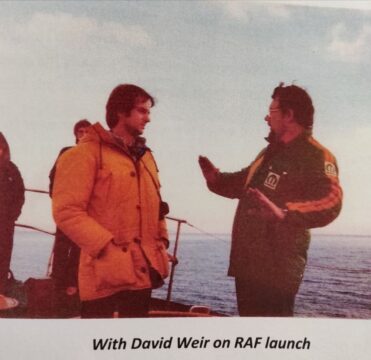
A lovely piece from David. John Couzens told me years back that everyone had hurried to get inside the sub before it submerged, leaving the camera line-up chart to a sad demise floating about on the ocean. We imagined a puzzled trawlerman fishing it out some days later….